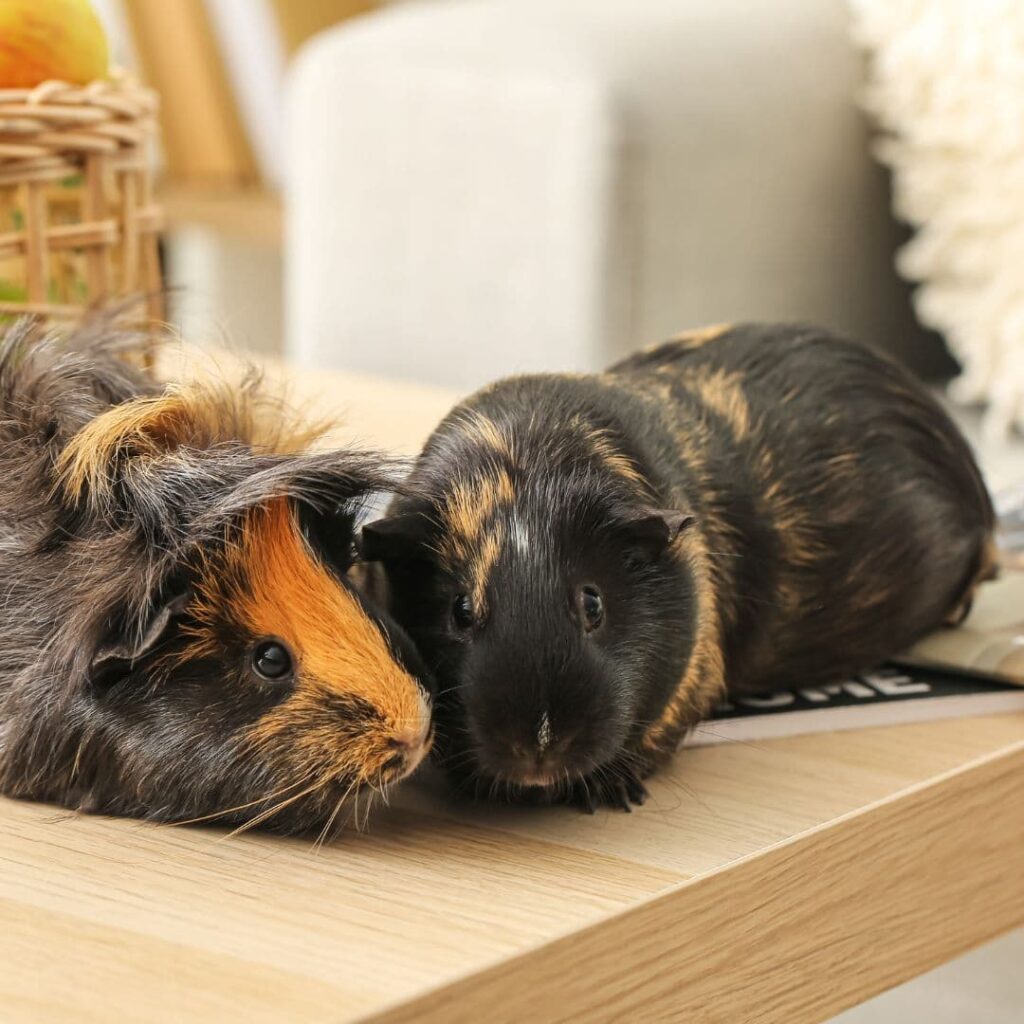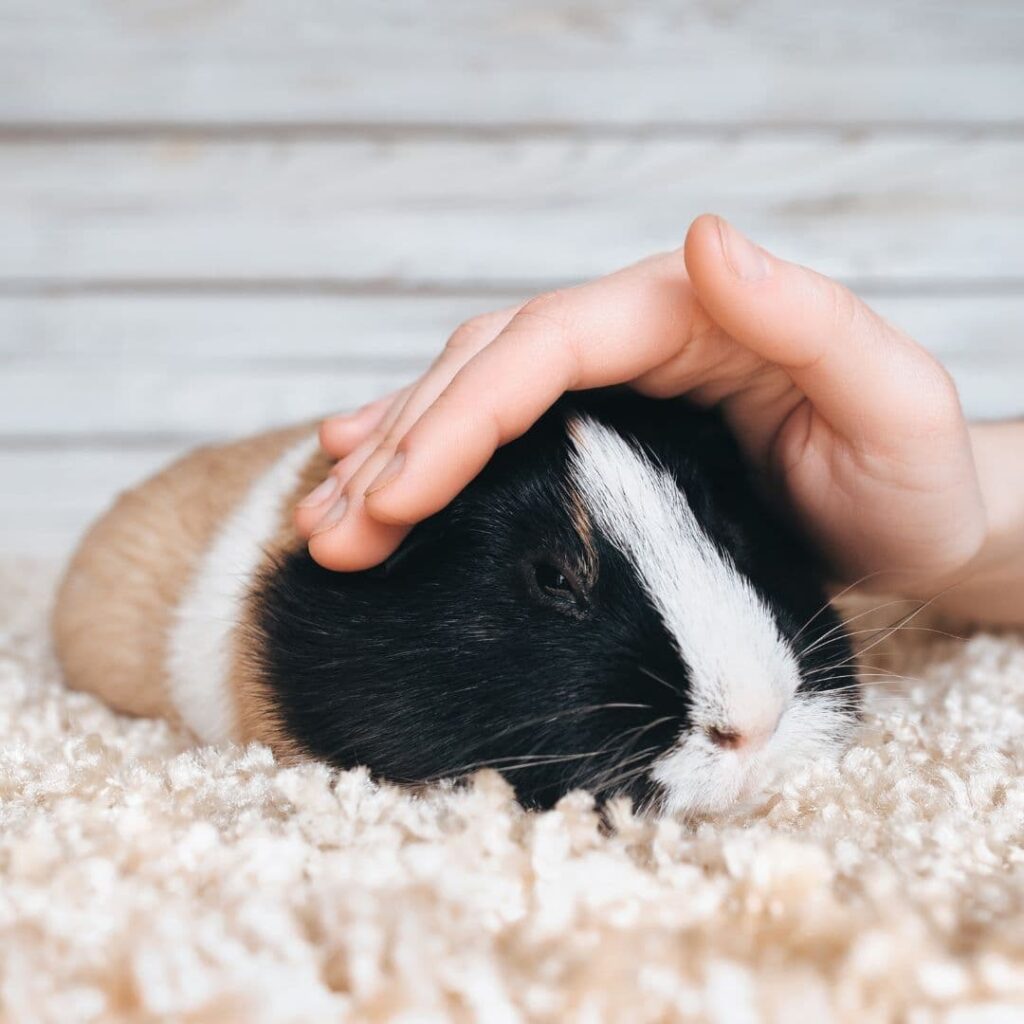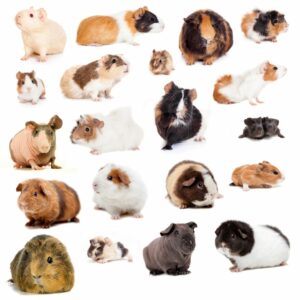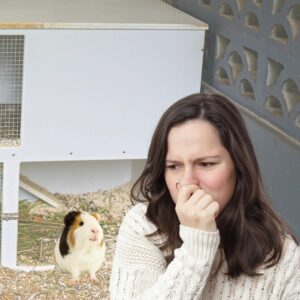If you’re concerned about your piggies being active during the nighttime – don’t worry. Guinea pigs are active nearly the entire day, whether in broad daylight or dark.
But, do guinea pigs like the dark?
Studies on guinea pigs’ vision and their behavior gave us some insight into this fascinating topic.
In this article, I’ll answer this question, explain their nocturnal behavior, how their vision works, whether they see colors or not, and more!
Table of Contents
Guinea Pig Vision
To better understand if guinea pigs like dark, first we need to have a quick look at their vision function. A research paper published in The National Library of Medicine concluded that:
- Guinea pigs have a wide visual field that extends about 270 degrees horizontally and 140 degrees vertically.
- Their retinas are relatively large and contain a high density of photoreceptor cells.
- Guinea pigs are crepuscular animals, meaning they are most active at dawn and dusk.
- Their vision is well-adapted for low-light conditions.
- Guinea pigs can distinguish different colors, but their color vision isn’t as good as ours.
Can Guinea Pigs See at Night?
The eyes of all guinea pig breeds work similar to ours; however, it has some limitations.
Guinea pigs, like most crepuscular animals, are active during the twilight hours, both dawn and dusk. This means they have evolved to navigate and forage in low-light conditions.
Their eyes are well-adapted to dim lighting, with large pupils that allow them to gather more light. Additionally, they have a reflective layer behind their retina, called the tapetum lucidum (tapetum lucidum is a layer of tissue behind the retina that reflects light back into the eye), which helps to enhance their vision in the dark.
For instance, guinea pigs have a low depth of field, meaning they can’t see as far away as we can. So, can guinea pigs even see in the dark?
Well, guinea pigs can barely see anything in the dark. But similar to other rodents, these cute cavies rely on whiskers and much more keen senses, making it easy for them to orient in the dark.
Helpful Whiskers
Their whiskers become like tiny antennas in the dark, helping them navigate their surroundings. Brushing against objects sends signals to their brain, letting them understand their surroundings better.
Just make sure not to touch your piggy’s whiskers, as these are extremely sensitive, and it can hurt your guinea pig.
Hearing
Hearing is another sense that guinea pigs rely on when moving around, especially in the dark when the vision is reduced. They have a high sense of hearing, a survival trait inherited from their prey instincts.
Guinea pigs can hear sounds from 54 Hz up to 50 000 Hz, allowing them to detect subtle environmental variations. This helps piggies to raise their situational awareness enabling guinea pigs to detect potential threats in their surroundings quickly.
Strong Smell
Guinea pigs have an impressive sense of smell. A guinea pig relies on their nose to sniff out familiar scents when it’s nighttime. This helps them identify their territory, food, and potential threats.
It’s like having a scent map of their environment. So, even if it’s pitch black, their keen sense of smell guides them through the darkness, keeping them aware of their environment.
Spatial Memory
Memory is another important ‘’tool’’ guinea pigs use to navigate around during the dark. These fluffballs have an excellent spatial memory. Once they’ve explored an area, they remember the complete layout like a map.
Guinea pigs have a special part of their brains that is dedicated to spatial memory.
In the dark, they can recall where their hideouts, food bowls, and favorite spots are.
Do Guinea Pigs Need a Night Light at Night?

The answer is a simple no – guinea pigs don’t need a night light at night. A night light can disrupt a guinea pig’s sleep cycle and make it difficult to rest properly.
It can also make them feel more anxious and stressed. If you are concerned about your guinea pig’s safety at night, you can provide them with a hiding place, such as a tunnel or a box, where they can feel safe and secure.
Here are some additional reasons why guinea pigs do not need a night light at night:
Guinea pigs are prey animals. In the wild, they would be hunted by predators at night. A night light would make them more visible to predators and could increase their risk of being attacked.
Guinea pigs need to produce melatonin. Melatonin is a hormone that helps to regulate sleep. Darkness is necessary for the body to produce melatonin.
Guinea pigs have a keen sense of smell. A night light could interfere with their ability to smell their surroundings.
If you are concerned about your guinea pig’s ability to see at night, you can talk to your veterinarian. They may recommend that you have your guinea pig’s eyes checked to make sure there are no underlying health problems.
Do Guinea Pigs Like Sleeping In the Dark?
Yes, guinea pigs like sleeping in the dark. Spending time in dark is one of their traits, inherited by their ancestors who were crepuscular – meaning they’ve been active during the night.
Even though they’re not naturally nocturnal animals, sleeping in dark places is comforting and provides piggies with peace of mind since they’re prey animals.
Sleeping in the dark also helps them to conserve energy. Guinea pigs are most active at dawn and dusk, and they need to conserve energy for foraging and other activities. Sleeping in the dark helps them to rest and recharge.
Is It OK to Cover My Guinea Pig Cage at Night?
If your guinea pigs are living indoors, there’s no need to cover their cage at night. Especially if you keep the room dark during nighttime because they like the dark.
On the other hand, low temperatures would be a good reason to cover their cage. If you notice your piggies feeling colder during wintertime.
If you don’t have space inside and you’re keeping your piggies outdoors, covering their cage during nighttime is mandatory to keep them warm and protect them.
Of course, ensuring the cage is still well-ventilated when covered is important. A blanket or towel can cover the cage, but ensure there are still gaps for air to circulate.
You should also avoid covering the cage entirely, as this can trap too much heat inside.
Here are some additional tips for covering your guinea pig cage at night:
- Use a lightweight, breathable fabric.
- Make sure the cover is not too tight or too loose.
- Leave some gaps for ventilation.
- Check on your guinea pigs regularly to make sure they are comfortable.
You can talk to your veterinarian if you are concerned about covering your guinea pig cage at night. They can provide more specific advice based on your guinea pig’s needs.
Overall, covering your guinea pig cage at night can be a good way to help them feel more secure, comfortable, and sleep better. Just follow the tips above to ensure your guinea pigs get enough air and are not too hot or cold.
The Balance Between Sleep and Activity
Now that you know guinea pigs like the dark, you may wonder, when should they sleep? The answer is a bit more complex. Guinea pigs are nap enthusiasts.
A healthy guinea pig is active about 20 hours per day, mostly takes short naps throughout the day, and rarely sleeps – typically just for few hours and sometimes even less than an hour.
While they enjoy ‘’night shifts’’, every guinea pig is different, and there’s no specific time of the day when your piggy should sleep – one may sleep while another is fully awake during nighttime, and vice versa.
Due to being prey animals, these dynamics between sleeping patterns among guinea pigs may be an instinctual behavior that keeps them alert if a predator is nearby.
Guinea pigs’ sleep patterns are also influenced by their age, health, and environment.
How to Help Your Piggy Get Better Rest

Since guinea pigs like to take cozy naps, snack, or even play around in dark areas, you should consider encouraging their instinctual behavior.
They also seek hideouts when they feel threatened by their surroundings or get startled by loud noises or sudden movements. So, how can you help your piggies find that nice, cozy hiding spot?
Let’s take a look at some of the most effective options.
Hideaway Tunnels
Hideaway tunnels are a great way to bring a comfy, dark place for your piggies to nap in. But a tunnel is also a great way to keep your piggies active and healthy.
Here are some cute hideaway tunnels to consider buying for your fuzzy friends:
Niteangel Fun Tunnel with 3 Pack Play Balls for Guinea Pigs
Hidey Huts for Napping
Most guinea pigs use dark spots in their habitat to take naps short naps or sleep for a while. This is why cozy huts made of soft, comfy materials can provide an excellent space for your piggies to rest after a long work day – it’s not easy to be that cute.
Here are some of the popular, quality hidey huts to check out:
A DIY Guinea Pig Hideout
You can be creative and improvise if your cage is too small to fit huts or hideaway tunnels for your piggies. For example, you could make DIY Hideouts for your piggies and surprise them – an excellent opportunity to make something special for them.
Here’s a quick step-by-step guide on how to make one:
Equipment
- Fleece fabric (colors or patterns depend on your piggy’s choice, of course)
- Scissors
- Ruler
- Cardboard box (shoebox-sized)
- Fabric glue or a sewing machine
Instructions
- Measure: Measure the guinea pig cage space where you want to place the hideout.
- Cut: Cut a doorway into one side of the cardboard box, ensuring it’s large enough for your guinea pig to enter comfortably.
- Prepare Fleece Strips: Cut the fleece fabric into strips approximately 1 inch wide and 4-6 inches long. However, feel free to consider the size yourself and experiment.
- Apply Fleece Strips: Using fabric glue or a sewing machine, attach the fleece strips to the outside of the cardboard box. Overlap the strips to create a cozy, insulated layer – this will be the outer layer of your hideout.
- Create a Fleece Bed: Cut a piece of fleece to fit the inside bottom of the box. Place this inside to make a soft and comfy bed for your guinea pigs.
- Finishing Touch: Trim any excess fleece from the doorway for a neat finish. Check if all edges are securely attached to the cardboard.
- Supervise: Now, all left is to observe your piggies and see how they react to their new hideout space. Ensure it fits properly inside the cage and that your piggies have enough space in their environment.
To see how the hideout should look like, for example, check out this short YouTube guide: How to Make a Guinea Pig Fleece Tunnel | Pigmas 2016
Do Guinea Pigs See Color
Among many fascinating facts about guinea pigs is their color vision. Guinea pigs can see colors. They have two types of cones in their eyes: the cells that allow us to see color. These cones are sensitive to light wavelengths, allowing guinea pigs to distinguish between colors.
Guinea pigs are dichromats, which means they can see two primary colors: yellow and blue. They can also see colors that are mixtures of yellow and blue, such as green.
My Senior Paws is a participant in the Amazon Services LLC Associates Program, an affiliate advertising program designed to provide a means for sites to earn advertising fees by advertising and linking to Amazon.com. We also participate in other affiliate programs which compensate us for referring traffic.




